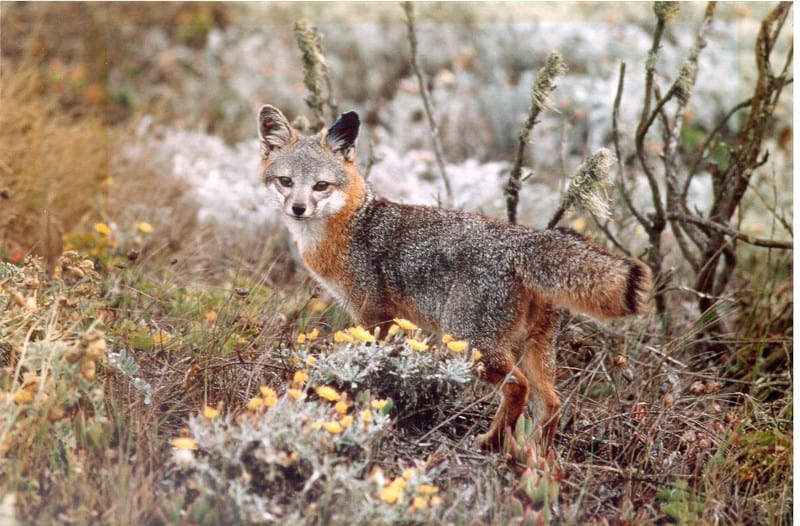
Island Fox Facts
- The term of Island Fox serves as the most often used common name for this intriguing member of the Canidae Family. It also goes by a variety of others. These include Coast Fox, Island Gray Fox, Channel Islands Fox, and Insular Gray Fox, among others.
- Among scientists, though, it’s typically referred to by its formal, technical name. Thankfully, that’s a relatively simple term, as such things go. That’s because this marvel of Nature and evolution holds the official moniker of the Urocyon littoralis.
- It received this name due to the efforts of the American researcher, Spencer Fullerton Baird. The respected naturalist made the first acknowledgement of the mammal as a separate and distinct species. He accomplished this noteworthy deed in 1857.
- It also holds a respectable position in the annals of science. This holds true due to the fact that a total of six known subspecies of the species also exist. Each of these subspecies additionally appears only in its own solitary, highly isolated habitat range.
- Four of those profit from federal protection. The Island Fox itself, however, does not. Presently, its population appears to be dwindling. That’s due to a combination of factors, both natural and artificial. The IUCN, therefore, lists it as Near Threatened.
- Most of the dangers it faces arise from human activities. These incluse such problems as introduced species, such as feral pigs. Others include diseases and parasites not native to its habitat. Its greatest threat, though, likely consists of climate change.
Related Articles
Island Fox Physical Description
The Island Fox easily draws the attention of those fortunate enough to encounter it. It’s worth noting, however, that it does so for reasons other than sheer size. That’s due to the fact that this fox qualifies as the smallest of all related species in its part of the world.
In terms of head-and-body length, mature adults average just 19.0 – 19.5 in (48 – 50 cm). The tail, though, varies significantly between individuals. This part of its body averages between 4.5 – 11. 5 in (11 – 29 cm). The reasons for such dramatic variations remains undetermined.
Its shoulder height leaves it small in stature. This varies, but averages 4.5 – 6 in (12 – 15 cm). It also displays the physiological characteristic of sexual dimorphism. In this case, the male attains a larger size than the female. Weights range from 2.2 – 6.2 lbs (1 – 2.8 kg).
It also strongly resembles its mainland cousin, the Gray Fox, in appearance. The greatest visual distinction between the two remains the length of the tail. The main source of that difference springs from the fact that the Island Fox has fewer vertebrae in that appendage.
Its pattern of coloring mainly differs in the degree of shading. That’s due to the fact that, generally speaking, this animal manifests a coat that’s slightly darker and duller than that close relative. The tail further distinguishes the two mammals in yet another manner.
This part of the body displays a black running most of its length. Its close relative lacks this distinctive marking. Otherwise, it manifests gray fur on its head, and a somewhat bright red on its sides. It additionally shows whitish fur on its throat, lower face, and stomach.
- Kingdom: Animalia
- Phylum: Chordata
- Class: Mammalia
- Order: Carnivora
- Family: Canidae
- Genus: Urocyon
- Species: U. littoralis
Island Fox Distribution, Habitat, and Ecology
The amazing Island Fox evolved as native to an overall region of the globe already renowned for its abundance of fabulous flora and fauna. That’s true since it developed as endemic to North America. Sadly, though, it only appeas in an extremely limited portion of it.
This marvel makes its home in a specific portion of the United States. That region’s further part of the state of California. To be specific, it lives on six of the eight islands comprising the Channel Islands of California. Evidence also indicates it never lived anywhere else.
In fact, each of the six subspecies appears on one island apiece. Both they, and the parent species, though, make the most of their situation. That’s because all of them live in every biomes present. These consist of temperate grassland, chaparral, and temperate forests.
Within these various regions, though, the animal displays a strong preference for one type of habitat. That’s partially formed by the presence of a complex layer of vegetation, such as grasses. Yet it also favors the presence of copious woody, perennial fruiting shrubs.
The Island Fox usually forms monogamous breeding pairs. It lives in dens, with the female giving birth to a litter of 1 -5 pups. These she bears in spring, with the young emerging in early summer. All live a principally nocturnal existence, with peaks at dusk and dawn.
Like its relatives, it evolved as a carnivore. Due to its size, however, it generally hunts smaller prey. This typically includes such creatures as lizards, crabs, birds, and small mammals, such as deer mice. It also occasionally supplements this diet with eggs, insects, and fruit.
Species Sharing Its Range
Check out our other articles on Texas Blind Salamander, Delhi Sands flower-loving fly, Victoria Falls, Caspian Seal, Moon Orchid, Black Mamba, Wilson’s Bird-of-paradise, Striped Possum
